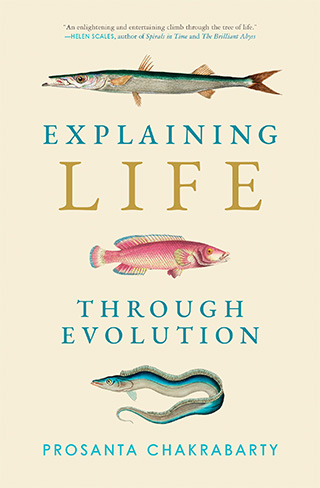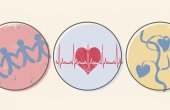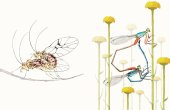What Evolutionary Biology Can and Can't Tell Us About Sex, Gender, and Sexuality

When my identical twins were born, I often pushed them around town in their huge orange double-wide stroller. Someone would eventually ask, “Twins?” “Yep, identical,” I’d reply, and sometimes I’d then get, “Boy and a girl?” and I would shake my head, thinking, “Don’t these folks know what ‘identical’ means?”
But I was the one who had some learning to do. Only later would I learn that some identical twins, who have matching genomes, could still end up being different sexes, and, of course, different genders too, including being nonbinary or gender-fluid. One way, although rare, is that during the formation of the sex cells (during meiosis), either the egg or the sperm might get two sex chromosomes rather than one, and then one of the developing twin embryos might end up with an odd number of chromosomes, so you might get an “XXY” male (“Klinefelter syndrome”) born alongside an “XX” female twin. Or, you might end up with a single “X” female (“Turner syndrome”) alongside an “XY” male twin.

“Sex” is complicated, much more so in the expression of physical traits than of the physical act. It is perhaps even more complicated than “race,” and, as we have done with human “races,” we have historically pigeonholed the spectrum of sex into discrete categories that don’t actually fit reality. Our contrived social abstractions often include treating “sex” as a synonym of “gender” and equating some forms of sexuality with “normal,” relegating all others to “abnormal” choices or preferences. It’s time we incorporated science into our understanding of these very normal human traits in their full spectrum of variation.
Like all human traits, sex, gender, and sexuality can be explained in the context of evolution — but I want to stress that you shouldn’t need evolutionary explanations to accept people for who they are. Unfortunately, however, there are still those who question why certain traits exist “if evolution is true.” So here I will try to dispel those myths and explain why the human variation around the different spectrums of sex, gender, and sexuality don’t contradict our scientific understanding of evolutionary biology.
As we have done with human “races,” we have historically pigeonholed the spectrum of sex into discrete categories that don’t actually fit reality.
There are actually dozens of ways your anatomical sex (whether you have a penis or a vagina) may not match your chromosomal sex (presuming XX female or XY male). One way is “androgen insensitivity syndrome,” where you do not express the male-associated genes that are on the Y chromosome. The genes that control “maleness” are actually remarkably few, and they can move around, sometimes even onto the X chromosome. How “male” or “female” (and everything in between) you may be physically depends largely on how your hormones signal from relatively few genes, including one particularly fickle gene called “SRY” (which is short for what it codes for, the “sex-determining region Y protein”). SRY is perhaps the most important gene for male sex-character development, but it doesn’t always stay on the male-associated Y chromosome. If, as a man, you still link your “manliness” to your Y chromosome, you might also be shocked to learn how much that chromosome degrades as you age, and how it can be lost altogether in most of the cells of many older men.
There are also many factors that can impact how someone might be “intersex” (not being male or female but having a combination of sex-related biological traits) to varying degrees. Research puts the proportion of intersex people at around 1.7 percent of the U.S. population, or roughly 5.6 million Americans. There are, as we will see, complex interactions between genes, hormones, and environment that determine how we express our sex. We still have a lot to learn about sex and how it is expressed.
Sex is one thing; gender is quite another. Gender is an expression of social and sexual identity unique to human cultures (and one that varies from culture to culture). You could say that gender is in your head, while sex is in your pants. In our culture, most people with male sex organs identify as men, but some identify as women. Similarly, some men have female sex organs, but most people with female sex characteristics identify as women; you might also identify outside of the male/female binary categories that are common but not fixed in many cultures. Your gender may also change over your lifetime, as it is a fluid trait for many people. The gender binary stereotype is often linked to sex and sexuality, but neither of these is binary; both are on spectrums across the Tree of Life.
What about other species, you ask? Although genders don’t exist in the animal kingdom, that doesn’t mean there is no variation in behaviors related to the expression of a given sex. There are species of animals where the males behave or appear to be more like the females to avoid competition. These “sneakers” use the advantage of appearing more like a female to mate with females when the bigger, more aggressive males are otherwise occupied posturing, threatening, or attacking one another. Although some would call what these “sneakers” do “deception” or “mimicry,” this does not explain why a female would prefer a “feminized” male to mate with. She isn’t being fooled.
Sex can also change over the lifetime of many species. Have you seen “Finding Nemo”? If it wasn’t a children’s movie, what would really happen when Nemo’s mother and siblings get eaten? Well, in nature, a little male clownfish like Nemo or his father Marlin would eventually become female — and a big, dominant female at that. Why? Clownfishes are sequential hermaphrodites; they are all born male and change into females when the opportunity arises, like when the big, dominant mama clownfish gets eaten. (Real life doesn’t always make for the best children’s movie.)
But, even in humans, your physical sex may change over time. In the Dominican Republic, there is a small community of children called “Güevedoces,” who appear female at birth until about the age of 12, when they develop penises. This early but passing testosterone deficiency that causes this change is common in that community, but occurs elsewhere, too.
Again, sex ≠ gender. Gender is more fluid than sex, and many people feel like they were “born in the wrong body.” There is a lovely book, “Becoming Nicole,” about a real family dealing with one of their identical twin boys who from a very early age showed an intense desire to be a girl. This kind of true story is still unfamiliar to many of us only because we (at least we in the West) have just begun to acknowledge and accept that some people may have similar feelings about their assigned gender. Other cultures have been much more accepting of recognizing fluid gender expression, especially in some parts of Southeast Asia, as well as some Native American communities.
Both twins in the “Becoming Nicole” story were assigned male at birth, but only one identified as female, Nicole, from the age of two. You may be wondering why, if gender identity is presumed to be at least in part genetic, did these identical twins, with the same genome, not express the same gender? Perhaps there is no genetic link to how gender is expressed, which is why it may be fluid over the lifetime of an individual. One other possible explanation is related to how genes are influenced by the environment (“epigenetics”). Identical twins aren’t exactly identical because of epigenetic factors, such as the way certain molecules interact with DNA (usually termed “methylation”); differences in identicals can also be caused by less subtle environmental factors. An identical twin raised alone in a cave with poor nutrition will look very different from one who grows up in a typical middle-class American family. Thus there may be both environmental and/or genetic factors that affect your sexuality and how you express your gender identity.
Although we don’t know what those environmental factors might be, it’s unlikely they include something your parents did. The fact that identical twins can express different sexualities and gender identities when raised in what seems to be the very same environment means there can be subtle environmental factors at play, factors that may involve the interactions of multiple genes. Even non-twin siblings raised together in the same environment may be affected by such factors.
Take, for example, the Wachowskis, who created the “Matrix” movie franchise: Born as male siblings two years apart, they are now both trans women. In about 20 percent of cases where one identical twin is trans, both are. The fact that identical twins more commonly share the same gender identity than non-identicals does point to a possible hereditary genetic factor (although both kinds of twins often share the same or very similar living conditions). What all this means is that gender, as we currently understand it, is harder to study and explain than either sex or sexuality. So what about human sexuality in the evolutionary context? I’m sometimes asked something like, “Why are there gay people, if so much of evolution is about reproduction and passing on your genes?”
Homosexuality has been documented in hundreds, if not thousands, of animal species. It’s not uncommon, unusual, or “unnatural.” My favorite example of same-sex mating in animals that I’ve seen personally are the three male elephants I encountered at a Sri Lankan preserve. The park ranger lovingly called them the “gay boys.” This miniherd was made up of a 30-, a 20-, and a 10-year-old elephant. Usually, male elephants are solitary, but these three were always together and often . . . “displaying their affections.”
We can observe and have observed same-sex mating in sexually reproducing animals across the animal kingdom, but gender is not so “straightforward” as sexuality in animals. An evolutionary biologist colleague, Jeremy Yoder, once told me, “You’re really not going to find a clear analogue to human transgender identity in the nonhuman world, because animals really only have gender in the sense that they have social behaviors and signals involved in mating.” That is, it would be a lot easier to infer gender expression in animals if all you had to do is notice, for instance, that a male elephant is acting like a female elephant, but most of the time elephants are, well, just acting like elephants, and you can’t tell them apart by their behavior. Anyway, there really is no need to impose a gender on animals that clearly don’t have one. Which leads me to wonder: Do humans need genders? I’m not sure we gain anything from these restrictive labels. If elephants don’t need them, maybe we don’t either? Certainly, I can’t think of why we need genders in an evolutionary context.
There is no reason we should expect only binary genders in any species where we see a spectrum of sexualities; so why should we do so in humans?
As a teenager, I worked at the New York Aquarium in Brooklyn, where two of the male penguins would later live and be celebrated as a same-sex couple. Same-sex pairings among captive penguins are not all that uncommon, and same-sex penguins that pair up are often given abandoned eggs to incubate and chicks to raise. Although some are even given “gay weddings,” we can’t really “gender” them in a way that parallels human behavior — nor do we need to. (On the other hand, the fact that penguins already look like they’re wearing tuxedos does make their weddings pretty cute, and having these weddings doesn’t hurt anyone and arguably serves to promote openness to and acceptance of the full spectrum of sexualities.) There is no reason we should expect only binary genders in any species where we see a spectrum of sexualities; so why should we do so in humans?
Of course, scientists are looking for genetic links to these traits to better understand them, although you can’t explain everything through genetics (see our discussion of gender above). Genetic studies of homosexuality have not yielded a “gay gene,” although there may be some weakly associated genetic markers that can potentially, but not definitively, identify same-sex sexual orientation. Many people are afraid these investigations will just lead to more and worse bigotry, or even to a future where homophobic parents “correct” these potential markers with gene-editing tools. The weak connections discovered between several genetic markers and same-sex behavior didn’t stop the ill-intentioned from producing a “How Gay Are You App” based on those results; worse still, it is distributed by a country that has criminalized gay sex, Uganda. Such an app and any others like it will only result in further stigmatizing the LGBTQIA+ community.
The search for “gay genes” is part of a new field of genetic research, often called “Genome-Wide Association Studies” (GWAS) in humans, but we would be far better served if these studies didn’t lead to more stigmatizing and demoralizing. The intentions of these studies may be to produce greater social acceptance by showing that particular behaviors have at least some genetic basis and are not simply “choices” or “preferences,” but their findings can readily be distorted to show just the opposite, sometimes with terrible consequences. Many of these GWAS papers cast a very wide net, and forget correlation doesn’t mean causation, particularly given the narrowness of the populations examined. On top of that, many traits are “polygenic” or influenced by many genes, and many genes are “pleiotrophic,” meaning that a single gene can have a small or large influence on many traits. The weak associations of many of the markers being examined in these GWAS examinations must be put in the context of the overall genetic architecture of our complicated genomes.
GWAS investigations have also been conducted to try to find genetic links correlating to income level and educational achievement. I understand the motivation for finding correlates in newly available genomic datasets for a variety of important social conditions and behaviors, but there is also a great need for scientists and science communicators who can clearly explain to the public the significance and proper context of such correlates, especially those found to be weakly associated. Even Aristotle divided his writings into the “exoteric,” for explaining his ideas to the average person, and the “esoteric,” reserved for his fellow philosophers and preeminent peripatetics. We would do well to remember that, poverty was once thought to be a heritable trait, one that American eugenicists wanted to eliminate through forced sterilizations.
We would do well to remember that, poverty was once thought to be a heritable trait, one that American eugenicists wanted to eliminate through forced sterilizations.
What does all this have to do with evolution? When people ask “Why are there gay people?” in an evolutionary context, they are really asking how come their “gay genes” don’t disappear if they aren’t producing offspring. Yes, even raising the question of why same-sex sexual behavior exists in an evolutionary context assumes that “normal” sexual behavior is different-sex sexual behavior, and reveals a certain ignorance about what “normal” sexuality actually is across the Tree of Life — but let’s try to answer it. After all, 7.1 percent of people surveyed in the United States self-identify as gay, lesbian, bisexual, or trans, which amounts to about 24 million Americans. Even that huge number may be an underestimate and might explain why evolutionary studies on human sexual orientation are generally difficult to conduct. Many people still live in fear of the prejudice they might face if they were to reveal this aspect of their lives.
One hypothesis for the existence of same-sex sexual orientation is that some of the genes for this trait are passed down by people who also have sex partners of the opposite sex with whom they produce children. There are also hypotheses that the genes for same-sex sexual orientation may be carried and passed down by relatives who are “straight” (of different-sex sexual orientation) and who carry these genes but do not express “alternative” sexualities themselves. And, in fact, there is evidence that the female relatives of gay men have more children than those without gay relatives, which could lead to the trait persisting, as these more fecund women pass down those “gay-ish” genes even if they themselves may be strictly heterosexual in their orientation and behavior.
In that scenario, the loci influencing same-sex sexual orientation would express themselves differently in these women (than in their gay relatives) and be passed from generation to generation by the straight (or at least the baby-making) relatives. There are nonreproductive members in many animal populations, and they pass on their genes by helping close relatives reproduce. Genetically speaking, you are passing down more of your genes by helping a sibling produce more nieces and nephews (who share about a quarter of your DNA) than having just a few of your own children (who share half of your DNA). You can imagine this system leading to more help for these fecund mothers from relatives who do not have their own offspring; those nonreproductive “helpers” in these scenarios are conjectured to be predominately gay. But most of these “gay helper” hypotheses and scenarios for humans are a little too simple and convenient in my opinion; more science please!
What we do know is that sex, sexuality, and gender do not track with one another as we once thought they did. Not only do people have a wide variety of sexual orientations in terms of who they’re attracted to, but many people are also born intersex in a multitude of ways (which they may not even be aware of), and gender can be expressed differently even within the lifetime of a single individual. There is variation in humans, as there is in all species, and although many societies have created social norms including binary categories for gender, sexuality, and sex, we know that those categories do not cast the net of human variation widely enough.
We should not let misinterpretation of scientific information lead to policy decisions that restrict freedoms based on behaviors we know are natural and variable. We need to do better, we need to educate one another and use inclusive language, and we need to be informed by the latest science to do so.
Prosanta Chakrabarty is Professor of Evolutionary Biology and Curator of Fishes at Louisiana State University. He is a TED Senior Fellow, an Elected Fellow of AAAS (American Association for the Advancement of Science), a Fulbright Distinguished Chair, and a National Geographic Certified Educator. Chakrabarty is the author of “Explaining Life Through Evolution,” from which this article is adapted.



